After my last post about mistrusting databases, Dermot Balson commented with a discreet little link to a chart of his that deserves to be brought out and displayed proudly to the wider world. Here it is:
It charts the number of people recorded at each age in the 1901 and 1911 censuses and confirms beautifully what most researchers in the censuses have long suspected. The rounded years (30, 40, 50, 60 and so on) are wildly over-represented – most people born before 1870 simply didn’t know their age. Not surprising, given that they never saw a calendar or celebrated a birthday.
Look at the chart longer and other things become clear. The drop in total population between 1901 and 1911. The bumps around the mid-decade ages (35, 45, 55 …), indicating that many of these were also just guesstimates. And my favourite, that improbable leap in numbers aged between 70 and 80 in 1911. The Old Age Pension was introduced in 1908 for people over 70, immediately making it very important to be at least that age. By the look of it, at least 30,000 individuals promptly suffered accelerated aging.
I contacted Dermot to ask his permission to use the chart and also if he had more. Look at a sample of what he came back with:
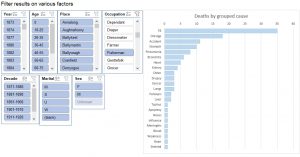
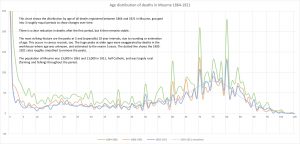
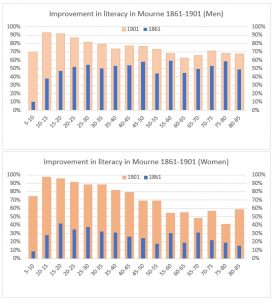
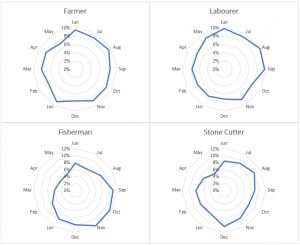
The latest YouTube video talks through all of these.
Dermot suffers from an advanced case of Albert-Casey-itis, where a researcher (usually descended from an Irish emigrant) runs out of ancestors but can’t stop. So he moves on to his ancestors’ neighbours, then to his ancestors’ neighbours’ neighbours, then to the entire locality … A truism of Irish research is that the border between genealogy and local history is very flimsy.
Like Casey, Dermot concentrates his record-collecting on the area his ancestors came from, the Kilkeel area in South Down. But as you can see, what he does is vastly superior to the Casey pile-em-high approach. A retired actuary, his spreadsheet skills are awesome. As he explained to me, he collects “transcriptions of all record sources in a single spreadsheet (with over 40 sheets), standardizing names so you can actually find records when you search, and linking births, deaths, marriages and censuses together, so that given a name, I can immediately find their marriage, a list of their children, their census records, any family deaths, newspaper references, and parent information where available, each of those with direct links to online scans.”
The end result will be the ultimate local and family history resource for the area. As a sample, Dermot has sent me a screenshot of part of his Excel file:
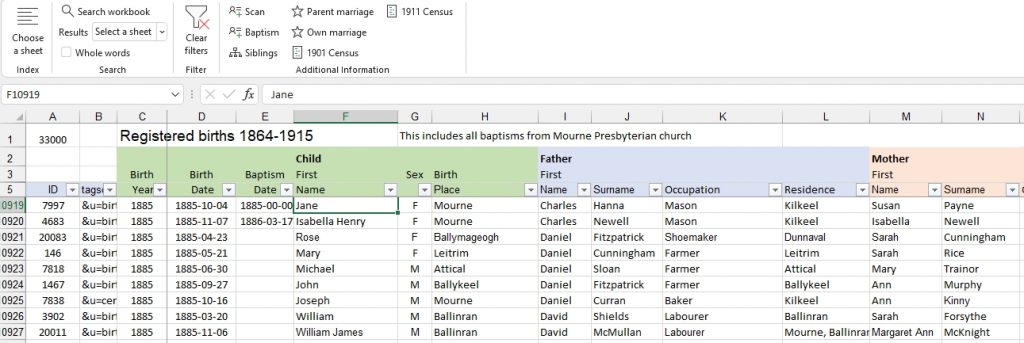
He’s anxious to spread the gospel far and wide and to share his data- here’s an extraordinary downloadable PDF of his analysis of Mourne death records.
There is at least one doctorate here for someone collaborating with him. Any Irish third-level institutions interested?
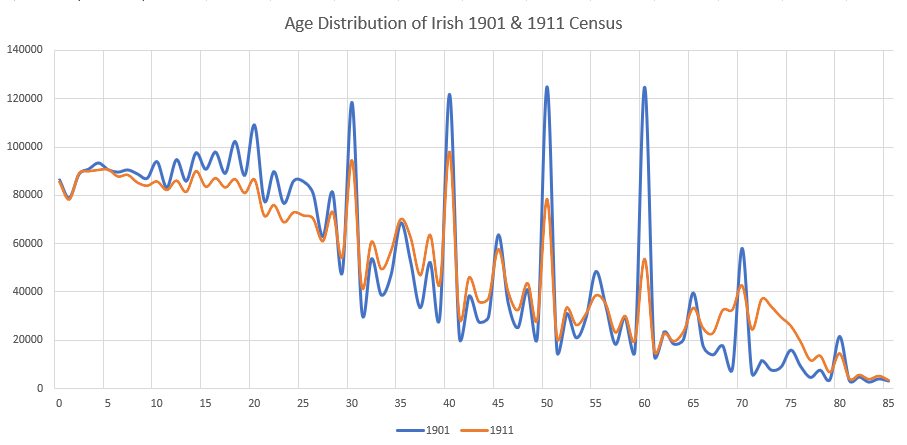
Wow! How I wish I were from his locality. This is great stuff indeed. Thanks for sharing.
Amazing amount on work put into this.
Absolutely brilliant stuff. Thank you so much for sharing, John and Dermot. The wonderful graph which illustrates the rounding of ages is truly fascinating to study and in a way, kind of reassuring as well. It’s very good to be reminded of how unlikely it would have been for our ancestors to accurately know their ages.
Such an interesting and thought provoking article. Big thanks again. ?☘️
Not being an actuary, I appreciate the interpretations. Not so sure about that pregnancy leap of presumable faith without DNA tests. . . .
I love these charts, especially the distribution analyses of reported age and age at death. I used to work a lot with large (US healthcare) databases in my professional life, and plotting the distribution of values of numerous variables was so helpful in helping to uncover data quality issues. I’m amazed at the work that must have gone into creating the databases behind these charts, though.
The plots on literacy by age are interesting, in that the rates for a given age category in 1861 often increase somewhat when you age that group by 40 years and check the reported rate in 1901. Were adults actually studying to become literate between 1861 and 1901? More likely to claim to be literate in 1901 whether or not they were? Or were literate people, perhaps more economically advantaged, more likely to survive 40 years and be around to report their status in 1901? Or were illiterate people more likely to migrate out? All of the above?
As someone who has tried to create a simple spreadsheet, I am in awe.
I love this:
“Dermot suffers from an advanced case of Albert-Casey-itis, where a researcher (usually descended from an Irish emigrant) runs out of ancestors but can’t stop. So he moves on to his ancestors’ neighbours, then to his ancestors’ neighbours’ neighbours, then to the entire locality …”
This is obvious my condition….I have created something similar for the extended family/families of my g-mother born in Graffy at 1882. I quickly learned that to get anywhere with Irish research are two insights:
1/ local families are mostly all inter-linked down the generations
2/ the key to sorting out which Brennan or McLoone belonged to which Brennan or McLoone family was to sort them out by Townlands.
3/ as far as possible support everything with some sort of source document – otherwise wrong info on other trees gets everyone confused.
So far I have 10 or more John Brennans…many in the same townlands,
so which one is which? the one married to Nancy Gallagher? or Susan McDevitt? or ? It was doing my head in! So of course, all the McLoone and Gallagher families (plus Timoney, Mulhern, Breslin, Boyle, Molloy, Moy, Gildea etc) families have had to be included too. So now my tree extends from Gweedore to Glenties, back up to Fintown and across to Letterkenny. Voila! the whole neighbourhood. …plus immigrations to New York, Philadelphia, San Francisco and Australia!
Thank you for the insight into the condition of Albert-Casey-itis!
In fact, I must have more than a double whammy …. as I have found this strategy the only way to make any sense of other grand & g-grandparents from Co. Clare and Co. Cork as well!
Is there any chance of creating a database of others with Albert-Casey-itus? I would be happy to help others (who are also willing to provide supporting documents for their assertions.)
Such information could become a new resource on this webpage – and might encourage others to fill in the gaps until we get the whole of Ireland covered with detailed extended trees.
Thx John, very cool stuff. Immense data….I am guessing this is the same Dermot who created the Matchmaker spreadsheet program we are using today in many Facebook Groups? It is a nice spreadsheet program which works with Gedmatch “one-to-many” data. It is very nice…
Amazing work, I’m astonished. Thank you for sourcing this for us to see.